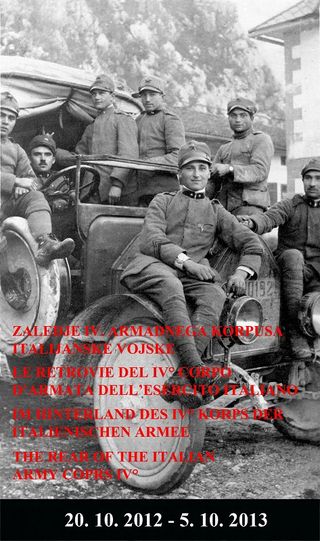The rear of the Italian army Corps IV°
20.10.2012 - 05.10.2013The exhibition calls visitors’ attention primarily by means of numerous photographs whose narrative is complemented by short quotations from the members of the Army Corps. The majority of stories about the untold suffering in the war vanished with its participants who had fallen victim to the fights. A large percentage of the members of the Italian infantry were illiterate, therefore their stories survive only through oral tradition.
Comprehensive written narratives were the privilege of the educated, and the celebration of the victory in the “Great War” led to publication in book form of some of them. While reading them, one has to keep in mind the spirit of the time, since in the era of fascism, starting only four years after the end of the war massacre, the exaltation of the ideals of “the redeeming of the holy Italian territories” from the oppression of the Habsburg monarchy undoubtedly helped the authors to find favour with the authorities.
Also the Leader and the Founder of the Empire himself, the onetime bersagiliere Benito Mussolini, offered for reading his own story. He is joined in the exhibition by Don Feliciano Marini, a “soldier of the Church and the Homeland”, medical assistant and later also army chaplain. Sometimes his writing is closer to an officer’s than a priest’s thinking, since the numbers of the wounded and the dead in certain actions seem to him an acceptable loss in the fight for ‘sacred’ goals. The enthusiasm of these two is balanced by Francesco Orlandi, the scribe in the 1st company of the 155th infantry regiment, who is constantly asking himself when the terrible war will end and the peace will finally reign again.
It is necessary to judge in a similar way also the idealized images of Slovenian population and Italian soldiers at various events, on picnics and at memorial celebrations and to take into account that they were adapted for the publication in media. Even the bersagliere Mussolini disbelieved them. A good description of the circumstances in the last year of the Corps’ activity is offered by the commander, lieutenant general Alberto Cavaciocchi. Because he was declaired to be one of the culprits for the defeat in the Kobarid Battle, he was not allowed to publish his book written in 1923. It was only published 83 years later, in 2006.
It is possible to gain a detailed insight into the organization and composition of the powerful Army Corps only by scrutinizing the extensive material in the Archives of the Historical Office of the Italian Army in Rome. Some documents from these Archives are merely symbolically included in this exhibition. An overall insight into the circumstances and coexistence of soldiers and local population in the rear is only provided by recent publications of investigations, outstanding among which is the book “Soča – Sveta reka” (The Soča –a Holy River) by the historian Petra Svoljšak.
The greatest credit for the encouragement, cooperation and communication of the materials for the exhibition goes to Petra Svoljšak, Guido Alliney, Ruggero Dal Molin, Mitja Juren, Guido Fulvio Aviani and Maurizio Matronola. Likewise, we warmly thank all other institutions and individuals that have contributed to the staging of this exhibition.

